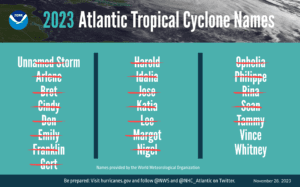Storm Tracker 2023
Storm Tracker 2023 Named Storms

Storm Tracker Recap
Hurricane Idalia was the only U.S. landfalling hurricane in 2023. It made landfall as a category-3 hurricane on Aug. 30 near Keaton Beach, Florida, causing storm surge inundation of 7 to 12 feet and widespread rainfall flooding in Florida and throughout the southeast.
Tropical Storm Ophelia made landfall as a strong tropical storm with 70 mph winds on Emerald Isle, North Carolina, on Sept. 23 causing widespread heavy rainfall, gusty winds and significant river and storm surge flooding in portions of eastern North Carolina.
Hurricane Lee made landfall as a post-tropical cyclone in Nova Scotia, Canada, on Sept. 16. Swells generated by Lee caused dangerous surf and rip currents along the entire U.S. Atlantic coast. Strong winds with hurricane‑force gusts from Lee caused extensive power outages in Maine and in parts of Canada.
The 2023 Atlantic seasonal activity fell within the NOAA Climate Prediction Center’s predicted ranges for named storms and hurricanes in the August updated outlook.
“The Atlantic basin produced the most named storms of any El Nino influenced year in the modern record,” said Matthew Rosencrans, lead hurricane forecaster at NOAA’s Climate Prediction Center — a division of NOAA’s National Weather Service. “The record-warm ocean temperatures in the Atlantic provided a strong counterbalance to the traditional El Nino impacts.”
Hurricane season activity for the eastern Pacific and central Pacific fell within predicted ranges.
“Another active hurricane season comes to a close where hazards from the storms extended well inland from the landfall location,” said NOAA National Hurricane Center Director Michael Brennan, Ph.D. “This underscores the importance of having a plan to stay safe whether you’re at the coast or inland.”
NOAA’s new Hurricane Analysis and Forecast System helped National Hurricane Center forecasters improve intensity predictions this season. NOAA’s intensity forecasts showed Hurricane Idalia as a major hurricane impacting the coast of Florida as early as Aug. 28. This lead time gave those in threatened areas more time to prepare and respond, and there were no storm surge fatalities from Idalia despite storm surge inundation of as much as 12 feet above ground level in some areas. Further, extending the National Hurricane Center’s tropical weather outlook product from five to seven days, this season provided emergency managers more time to prepare and stage resources before a storm.
Please follow the guidance and warnings of local weather warning systems & services
Do not make safety decisions based on this page’s contents
We provide to Our Clients & Partners – For Informational Use Only
National Hurricane Center Storm Tracker
(no data/images)
Spaghetti Models Storm Tracker
(no data/images)
Aviation Wind Plots Storm Tracker
(no data/images)
